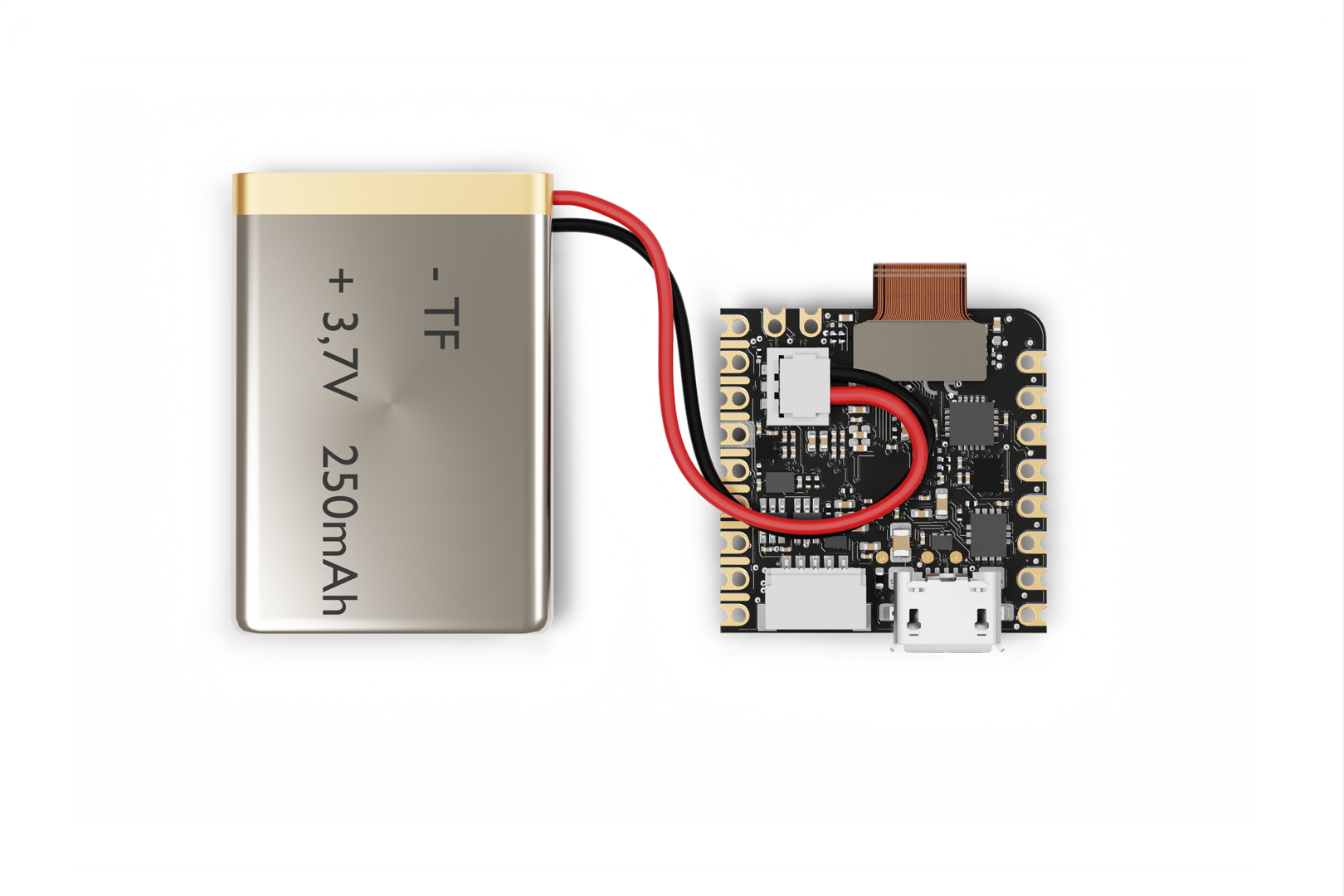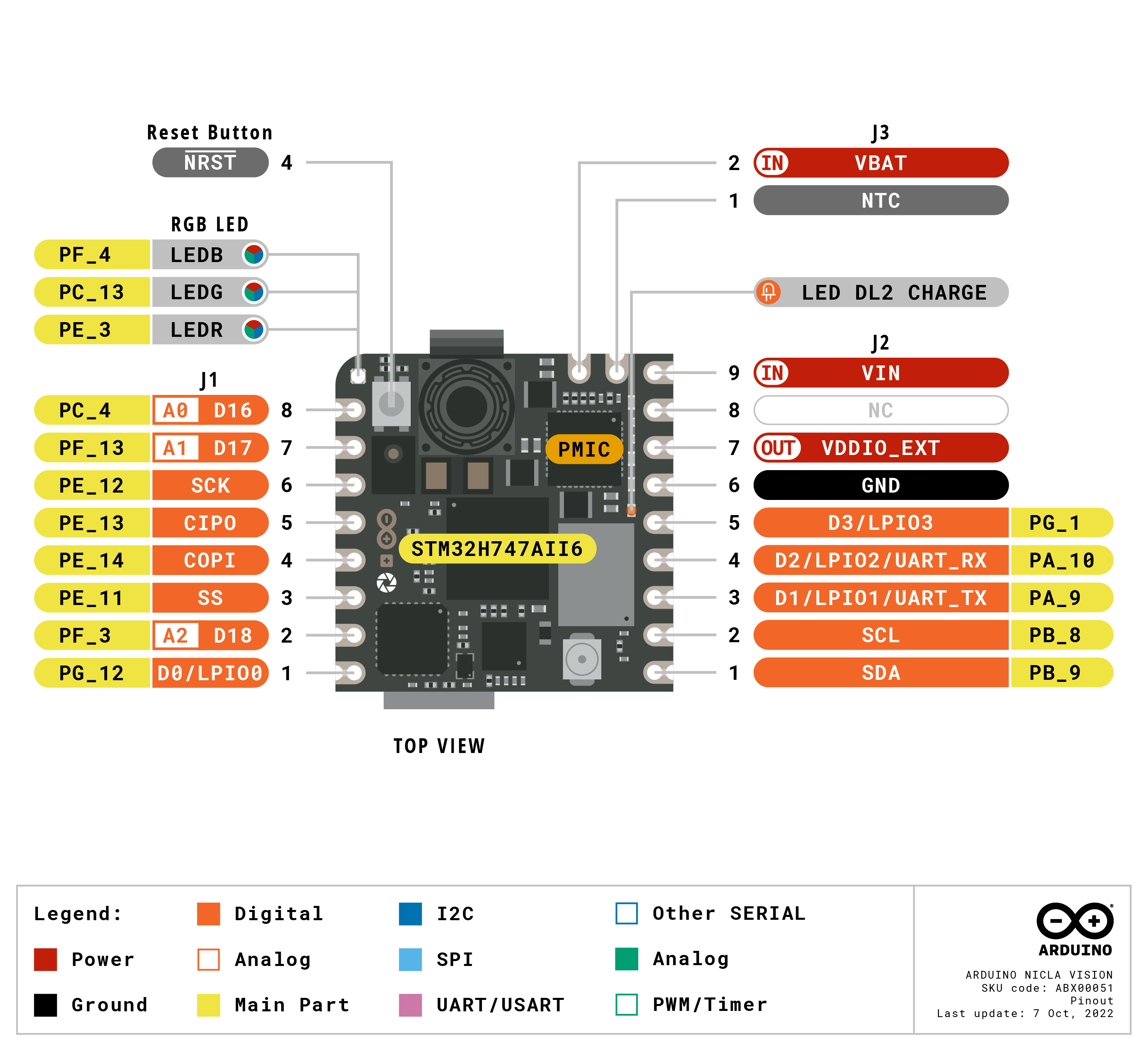
Overview
Nicla Vision allows you to build your next smart project. Ever wanted an automated house? Or a smart garden? Well, now it’s easy with the Arduino IoT Cloud compatible boards. It means: you can connect devices, visualize data, control and share your projects from anywhere in the world. Whether you’re a beginner or a pro, we have a wide range of plans to make sure you get the features you need.
Nicla Vision combines a powerful STM32H747AII6 Dual ARM® Cortex® M7/M4 IC processor with a 2MP color camera that supports TinyML, as well as a smart 6-axis motion sensor, integrated microphone and distance sensor.
You can easily include it into any project because it’s designed to be compatible with all Arduino Portenta and MKR products, fully integrates with OpenMV, supports MicroPython and also offers both WiFi and Bluetooth® Low Energy connectivity. It’s so compact – with its 22.86 x 22.86 mm form factor – it can physically fit into most scenarios, and requires so little energy it can be powered by battery for standalone applications.
All of this makes Nicla Vision the ideal solution to develop or prototype with on-device image processing and machine vision at the edge, for asset tracking, object recognition, predictive maintenance and more – easier and faster than ever. Train it to spot details, so you can focus on the big picture.
Key benefits include:
- Tiny form factor of 22.86 x 22.86 mm
- Powerful processor to host intelligence on the edge
- Packed with a 2MP color camera that supports TinyML, smart 6-axis motion sensor, microphone and distance sensor
- Wi-Fi and Bluetooth® Low Energy connectivity
- Supports MicroPython
- Standalone when battery powered
- Expand existing project with sensing capabilities, make MV prototyping faster
Automate anything
Check every product is labeled before it leaves the production line; unlock doors only for authorized personnel, and only if they are wearing PPE correctly; use AI to train Nicla Vision to regularly check analog meters and beam readings to the Cloud; teach it to recognize thirsty crops and turn the irrigation on when needed.
Anytime you need to act or make a decision depending on what you see, let Nicla Vision watch, decide and act for you.
Feel seen
Interact with kiosks with simple gestures, create immersive experiences, work with cobots at your side. Nicla Vision allows computers and smart devices to see you, recognize you, understand your movements and make your life easier, safer, more efficient, better.
Keep an eye out
Let Nicla Vision be your eyes: detecting animals on the other side of the farm, letting you answer your doorbell from the beach, constantly checking on the vibrations or wear of your industrial machinery.
It’s your always-on, always precise lookout, anywhere you need it to be.

Arduino IoT Cloud Compatible
Use your MKR board on Arduino's IoT Cloud, a simple and fast way to ensure secure communication for all of your connected Things.
TRY THE ARDUINO IOT CLOUD FOR FREE
Need Help?
Check the Arduino Forum for questions about the Arduino Language, or how to make your own Projects with Arduino. If you need any help with your board, please get in touch with the official Arduino User Support as explained in our Contact Us page.
Warranty
You can find your board warranty information here.
Tech specs
| Microcontroller | STM32H747AII6 Dual Arm® Cortex® M7/M4 IC:
|
| Sensors |
|
| I/O | Castellated pins with the following features:
|
| Power |
|
| Dimensions | 22.86 mm x 22.86 mm |
| Memory | 2MB Flash / 1MB RAM 16MB QSPI Flash for storage |
| Security | NXP SE050C2 Crypto chip |
| Connectivity | Wi-Fi / Bluetooth® Low Energy 4.2 (Murata 1DX - LBEE5KL1DX-883) |
| Interface | USB interface with debug functionality |
| Operating temperature | -20° C to +70° C (-4° F to 158°F) |
Conformities
Resources for Safety and Products
Manufacturer Information
The production information includes the address and related details of the product manufacturer.
Arduino S.r.l.
Via Andrea Appiani, 25
Monza, MB, IT, 20900
https://www.arduino.cc/
Responsible Person in the EU
An EU-based economic operator who ensures the product's compliance with the required regulations.
Arduino S.r.l.
Via Andrea Appiani, 25
Monza, MB, IT, 20900
Phone: +39 0113157477
Email: support@arduino.cc
Documentation
SCHEMATICS IN .PDFPINOUT IN .PDFDATASHEET IN .PDF
Pinout Diagram

Download the full pinout diagram as PDF here.
Learn more
Get Inspired

Makers have long asked the question “why bother with an expensive PLC when I can just use an Arduino?” The answer comes down to the priorities and needs of industrial clients. In a factory automation setting, the client will prioritize durability, reliability, and serviceability over the one-time purchase price of the device itself. But to prove that Arduino’s professional turnkey solutions are just as easy to use as their developer-focused educational counterparts, Jeremy Cook leveraged an Arduino Opta micro PLC to build a drum machine. This isn’t any old drum machine that plays sound samples or synthesized notes, but rather a robotic drum machine that makes noise by banging on stuff like a true percussion instrument. Cook could have built this with any Arduino board and a few relays, but instead chose to implement the Opta and new Opta Digital Expansion. That is robust enough for serious commercial and industrial applications, but is still simple to program with the familiar Arduino IDE. Programmers can also use conventional PLC languages if they prefer. In this case, Cook made noise with relays and solenoids. The Opta has four built-in relays and Cook’s sketch flips one of them to make a sound analogous to a hi-hat. Cook added an Arduino Pro Opta Ext D1608S module with its solid-state relays for the other two “drums.” One of those fires a solenoid that taps a small hand drum (the kick drum sound), while the other controls a solenoid that hits a power supply enclosure (the snare sound). Together, those three sounds can cover the basics of a drum track. Cook’s sketch is a drum sequencer program that stores each sound sequence as array, looping through them until turned off. An Opta may be overkill for a project like this one, but this does a great job of demonstrating the ease at which an Arduino user can transition to professional PLC work.











